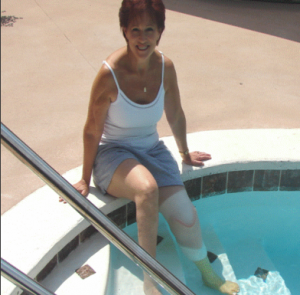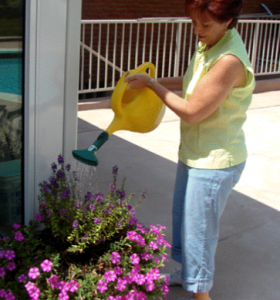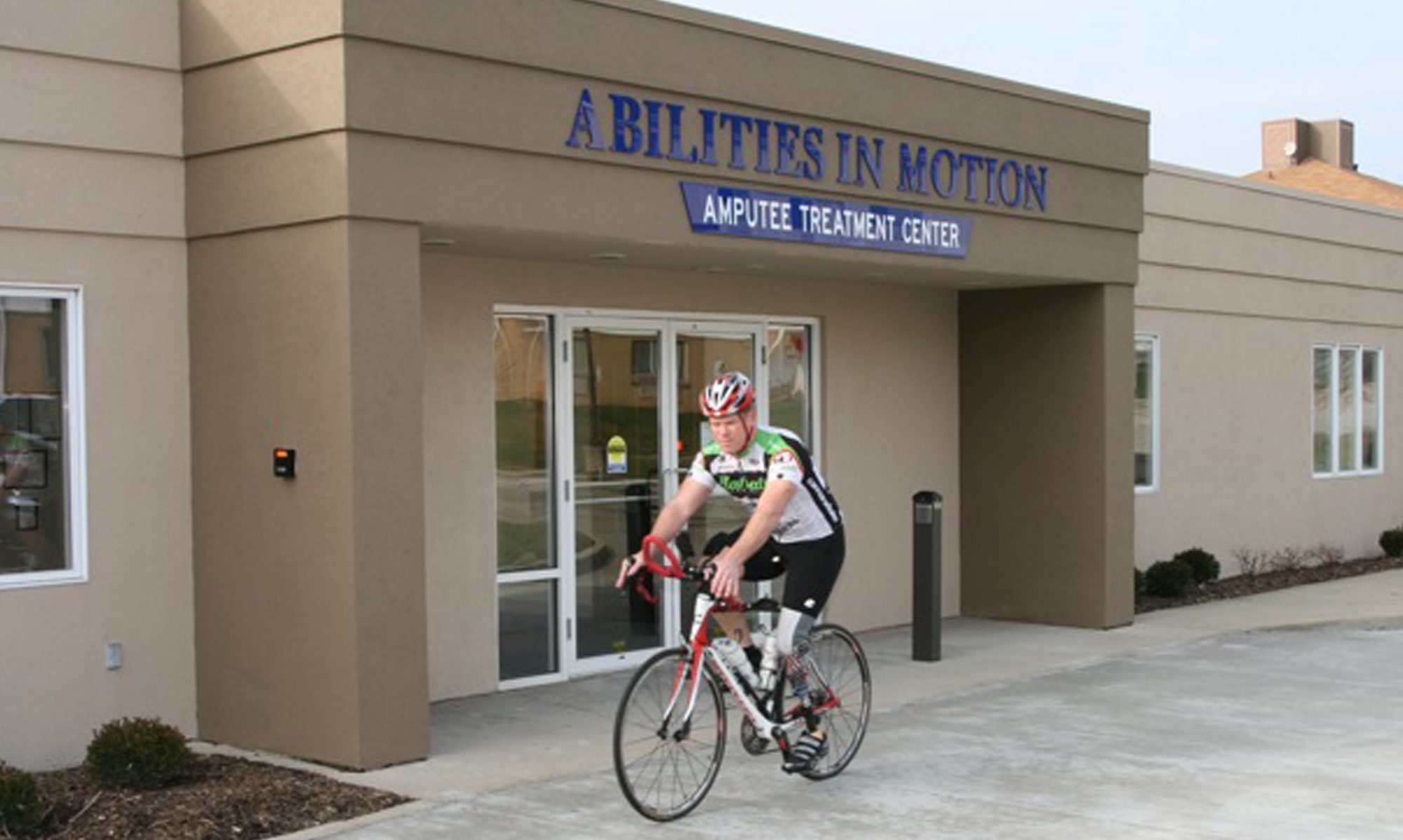 Jan Beckemeyer first came to AIM in August of 2005, for a consultation considering a below knee amputation. She had been through multiple surgeries after a motorcycle accident, which resulted in an artificial ankle. She had continued pain which was not improving, and it had become increasingly difficult to function.
Jan Beckemeyer first came to AIM in August of 2005, for a consultation considering a below knee amputation. She had been through multiple surgeries after a motorcycle accident, which resulted in an artificial ankle. She had continued pain which was not improving, and it had become increasingly difficult to function.
Jan is very active and was considering an ankle fusion or an amputation. After speaking with her surgeon, Tom Walsh, and several of AIM’s patient advocates, she decided to undergo a below knee amputation on September 21st 2005. She remarked, “at some point you get to the stage where you have to decide if you want to continue a life of pain, or take a chance on another way. I knew there was a chance that I may not get all that I was looking for, but I was willing to take the chance, and for me it has worked out really well”. Together with her husband, Ron, a retired engineer, they discussed the pros and cons and educated themselves on what was ahead.
Jan was initially fitted with an Immediate Post Operative Prosthesis, which allowed for early ambulation. She experienced some phantom pain, but otherwise healed very well. By mid October she was fitted with a prosthesis and started the road to rehabilitation.
 Within a month Jan had moved from a walker to a single cane, and shortly after Jan was walking unassisted. She progressed quickly and soon began researching different feet to compliment her active lifestyle. Working as a surgical technician meant standing for long periods in flat shoes, while her social life demanded higher heel shoes.
Within a month Jan had moved from a walker to a single cane, and shortly after Jan was walking unassisted. She progressed quickly and soon began researching different feet to compliment her active lifestyle. Working as a surgical technician meant standing for long periods in flat shoes, while her social life demanded higher heel shoes.
Jan volunteered to participate in some product development trials with a local manufacturer and AIM. Together an ankle which allowed adaptation of heel height change and dynamic movement was developed. Jan continues to help with this products next stage of development.
Jan has joined the team of patient advocates that AIM has to assist new patients with educating themselves on prosthetic issues from a patient perspective. She is also active in statewide patient avocation. She is working with Tom and others in the state to ask the Ohio legislator to pass a Prosthetic Parity law, which would require insurance companies to cover prosthetics under the same rules as Medicare.
 Jan has returned to her summer activities of boating and frequently visits the lake with friends and family. AIM designed an Aqualimb for her so that she could return to water activities and also use the shower.
Jan has returned to her summer activities of boating and frequently visits the lake with friends and family. AIM designed an Aqualimb for her so that she could return to water activities and also use the shower.
Jan has a fantastic attitude and outlook, which coupled with her sense of humor, has helped her transition back to a full and active lifestyle. The adjustable heel ankle has allowed Jan to use a large variety of shoes for all occasions. Which is just as well as Jan has many, many shoes.
A fact she proved when asked to bring a selection of shoes to an appointment, we heard the beeping of the truck backing up! Of course Jan said she only brought a small selection!
New Technology
We are a certified facility for not only the latest in microprocessor knee units but also for the newest generation of elevated vacuum sockets.
Ohio Willow Wood’s Limb Logic system, enables the patient to have control over the amount of vacuum applied through a remote control. The vacuum pump is located in the build of the prosthesis below the socket. It is charged each night just like a cell phone.
The device adds approximately 0.4 lbs of weight to the prosthesis and utilizes an additional sleeve on the outside of the socket to create a seal. There is also additional maintenance to be considered when choosing such a device. However, users have reported significant increase in the feeling of security and comfort.
Don McKenzie has been a wearer of traditional non-pin vacuum systems for many years. He recently was fitted with the Limb Logic system. Don commented, “this exceeded my expectations for comfort, it is by far the most comfortable system I have ever had”.
Call us for more information if this system interests you. (513) 245-0253





 Walter Lickliter, 57 had a right below knee amputation in July of 2004. Walter also has a left partial foot amputation. His main goal before surgery was to improve his balance and begin the process of learning to walk again. Within two weeks of being fit with his prosthesis, Walter said “I am encouraged by my progress from wheel chair to walker. I have not had any pain since just after the surgery”. He learned quickly through experimentation how to use socks to obtain a correct fit and does not feel his prosthesis limits him. “I like the comfort of my prosthesis and just being able to walk again”.
Walter Lickliter, 57 had a right below knee amputation in July of 2004. Walter also has a left partial foot amputation. His main goal before surgery was to improve his balance and begin the process of learning to walk again. Within two weeks of being fit with his prosthesis, Walter said “I am encouraged by my progress from wheel chair to walker. I have not had any pain since just after the surgery”. He learned quickly through experimentation how to use socks to obtain a correct fit and does not feel his prosthesis limits him. “I like the comfort of my prosthesis and just being able to walk again”.
 Sarah Ammons underwent surgery for a below knee amputation in 2002. Sarah said “I expected to have less pain, as I have a great deal of phantom pain”. She did not expect to be walking unassisted immediately, “I expected a long rehab”. Although undergoing a second surgery earlier this year, she is walking without assistance.
Sarah Ammons underwent surgery for a below knee amputation in 2002. Sarah said “I expected to have less pain, as I have a great deal of phantom pain”. She did not expect to be walking unassisted immediately, “I expected a long rehab”. Although undergoing a second surgery earlier this year, she is walking without assistance. Sam Crosby has a left below knee and a right partial foot amputation. For Sam, a former college quarterback, rehab went very smoothly. “I just expected to be able to walk and I pretty much did. I knew I would be able to walk without crutches”. Sam reported that he never really had any pain and that learning sock fit was easy.
Sam Crosby has a left below knee and a right partial foot amputation. For Sam, a former college quarterback, rehab went very smoothly. “I just expected to be able to walk and I pretty much did. I knew I would be able to walk without crutches”. Sam reported that he never really had any pain and that learning sock fit was easy. David Fischer became an above knee amputee just a few months ago in May. David says he wasn’t really sure what his expectations were prior to surgery as it happened so quickly. He said of his expectations upon receiving his prosthesis “I didn’t expect I would just get up and walk. I had a pretty good idea about the rehab process”. After initial fitting and physical therapy, David says he was more confident of being able to return to normal mobility. He has suffered from some phantom pain “but I’m managing well”.
David Fischer became an above knee amputee just a few months ago in May. David says he wasn’t really sure what his expectations were prior to surgery as it happened so quickly. He said of his expectations upon receiving his prosthesis “I didn’t expect I would just get up and walk. I had a pretty good idea about the rehab process”. After initial fitting and physical therapy, David says he was more confident of being able to return to normal mobility. He has suffered from some phantom pain “but I’m managing well”.